
Dunning emails: tips, tricks, and a template for success
Overdue payments. Outstanding invoices. Billing errors. What do all three have in common? For one, they’re contributors to churn—the nemesis of SaaS and subscription companies everywhere. But most importantly, they’re all easily mitigated by dunning emails.
Dunning emails, also known as payment request emails, are transactional messages sent to customers reminding them of a due payment. While that may sound simple enough, dunning emails are nothing if not powerful. They are vital to any SaaS or subscription business’ retention strategy.
Here’s why.
A churn benchmarks report from Recurly found that 72% of all failed payments can be recovered. All you need is the right strategy for alleviating payment issues!
That’s where dunning emails come in.
Of course, dunning emails are an art in and of themselves. From the timing and automation triggers to the subject line and body copy (hint: personalization is key), getting your dunning email strategy right is essential.
When you do, your dunning emails will work as friendly, polite reminders of your product value, reinforcing your customers’ desire to continue using your tool for years to come.
Here’s everything we’ll be diving into today:
- Dunning email best practices
- 7 dunning email examples from brands you’ll want to borrow
- 3 dunning email templates (with Customer.io Journeys!)
- Unlocking success: More tips and tricks for getting paid on time

Dunning email best practices
Your dunning emails should seamlessly guide customers to turn late, missed, or failed payments into recovered revenue for your company. That’s where your email’s timing, tone, and content come into play.
Timing is (almost) everything
Strategically timing your dunning emails can be the linchpin between success and failure. Dunning has three key stages: pre-dunning, dunning, and post-dunning. During each, you want to ensure your message hits the right chord at the right moment.
Let’s look at this from the viewpoint of an example company: a B2B EdTech business that provides access to online training courses for leadership development. While they offer standard monthly and annual subscriptions, they invoice some larger clients on 90-day net terms. We’ll pretend this flow is targeting those larger customer accounts.
Pre-dunning
Before churn delinquency even happens, the company can stop it with two gentle reminders that a payment due date is coming soon.
- Email 1: Trigger one month before payment is due. This email will be a simple reminder to the customer that they will soon need to re-up their payment. It should be straightforward and to the point: provide the customer with the billing due date and let them know how to make payment.
- Email 2: Trigger one week before payment is due. As the due date approaches, the educational company may want to remind the customer again that the payment deadline is fast approaching. Mixing in a bit of urgency messaging here helps nudge the customer to take action.
Dunning
As the payment due date arrives, it marks a crucial moment in ensuring the seamless continuation of services for the education company’s customers. A well-timed dunning email can make all the difference between disruption and business-as-usual for customers.
- Email 3: Trigger just after the day of expiry. Prompt communication within a few days of when payment was due demonstrates the education company’s commitment to transparency. Most charge failures are due to temporary issues, which retrying the card solves. We recommend sending this dunning email a few days after the initial payment failure.
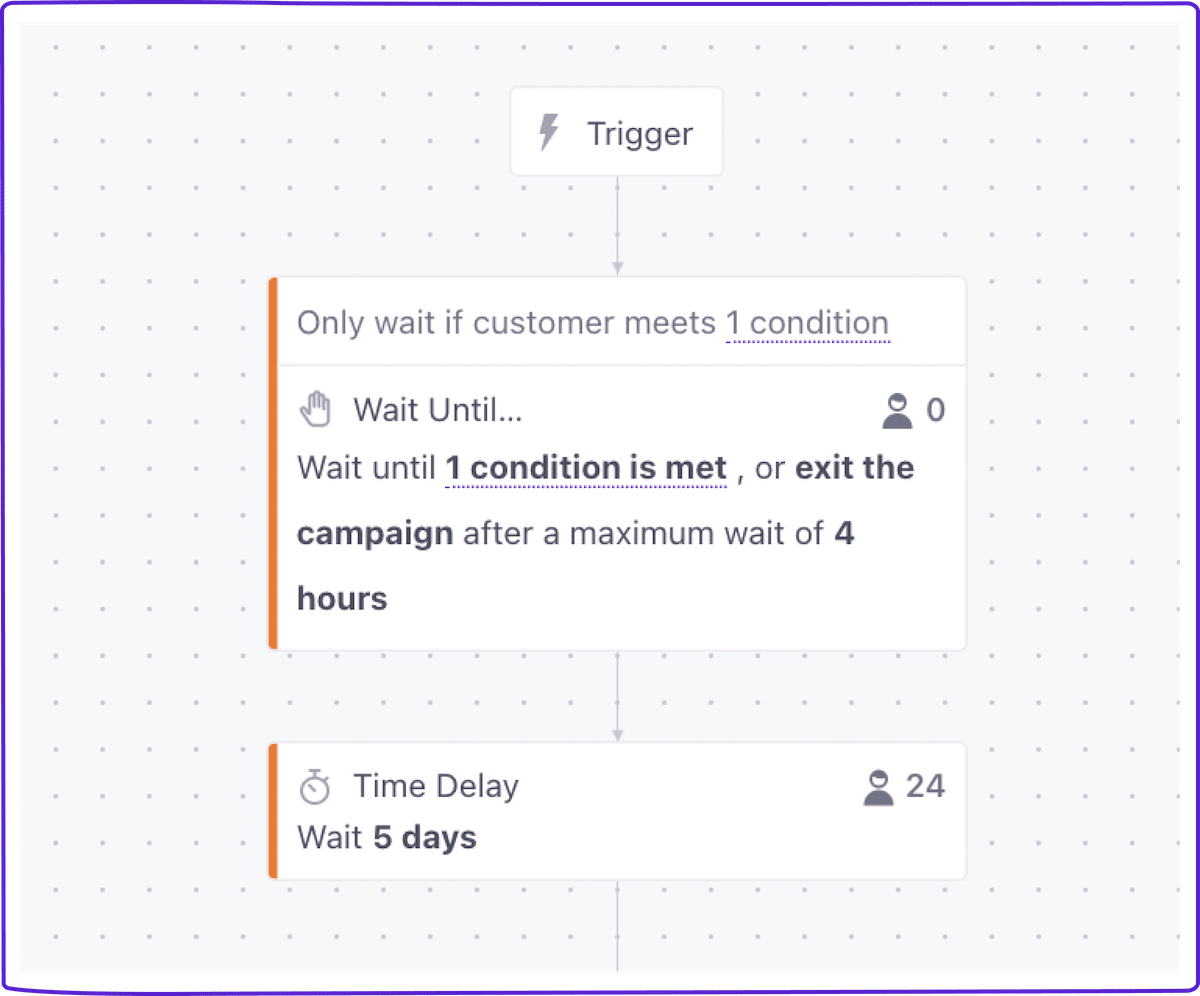
Post-dunning
The reality is that dunning happens at most SaaS and subscription businesses. To ensure continued support and satisfaction for the education company’s customers, you should send the after-expiration email relatively soon after payment is due.
- Email 4: Trigger five days after expiry. This payment request email should combine urgency with understanding. The company will want to encourage prompt action while making it clear that payment is now overdue—and the consequences of not making a payment.
Pro tip: While we recommend following up quickly about a critical billing issue, allowing adequate time between reminder messages is kinder and more productive. The company could use a Time Delay between each post-dunning email of at least three days. They may also include Time Windows for each email to ensure the campaign only sends emails during weekday working hours (in the customer’s timezone).
Tone: It’s not what you say but how you say it
In the delicate dance of dunning emails, the tone you use throughout your communication is critical. How you communicate can significantly impact how customers respond to your payment requests.
Remain polite and empathetic, always
- Compassion, goodwill, and cooperation are relationship-building and can help lead to a positive resolution. Consider that the customer may be facing payment challenges—and if possible, offer ways to lessen the burden. If your company provides options to pay by installments or discounts based on company size or industry (i.e., for non-profits or startups), communicate that in your email.
- Example: “Life happens! We understand that making payments on time can sometimes take a backseat to everything else on your plate. We’re here to help make the process easier for you. {Insert offer for installment payments/discounts based on industry type}.”
Pro-tip: Above all, ensure your tone is consistent with how your company messages customers. If you have enterprise customers, a more formal approach might be appropriate. A personal approach might work best if you have startup and growth-stage customers.
Scale urgency
- Tailor the urgency of your dunning emails based on the stage of the collections process. For example, you might start with a gentle reminder that payment is due and end with a final notice.
- Urgency should become more pronounced the closer you get to the payment deadline. Yet, remember: a respectful and professional tone is always required.
- Example: “Heads up! Your payment is {coming up/now due/past due}. As a reminder, your prompt attention to this matter will ensure uninterrupted access to our tools and service.”
Content: Keep your dunning emails conversion-centered
Now that we understand the importance of tone and timing, let’s look at the content of your dunning emails. Every dunning email should contain a few essential elements to keep them conversion-centered and compelling.
Use clear subject lines and preheaders
- The subject line and preheader text are the first pieces of content the customer will see. Keep them short, simple, and to the point. Don’t mislead your customer or use vague language. They should work together to encourage an open.
- Example subject line: “Action required: Your payment is due today.”
- Example preheader: “Keep your account active by completing your payment.”
Make the CTA prominently visible
- Whether it’s a button or link (or, better yet, both!), prioritize the CTA of your dunning email in your content hierarchy using color and styling.
- Reducing friction during the dunning process is important to ensure a faster conversion. If possible, ensure the CTA deep links to the customer’s billing page within your application.
Include invoice details (if applicable)
- If relevant, add the overdue invoice number and consider using an image of it within the body of the email for clarity. This provides extra transparency and will remind the customer what they are paying for.
Include the customer’s payment details
- It’s crucial that your dunning email clearly communicates the outstanding balance, due date, payment method, and penalties associated with an overdue payment.
- Make this information scannable with short paragraphs, bullet points, or subheadings for a better user experience.
7 dunning email examples you’ll want to borrow
With the basics for timing, tone, and content in hand, let’s see dunning emails in practice. We’ll look at what works, and you’ll get ideas on improving your lifecycle delinquency campaign.
Dunning email example #1: Spotify
Let customers know you’re taking action on an outstanding payment without their intervention. Spotify gives a playful nudge by notifying customers of their attempts to resolve the issue. This “no worries” approach is a helpful message rather than a scolding.
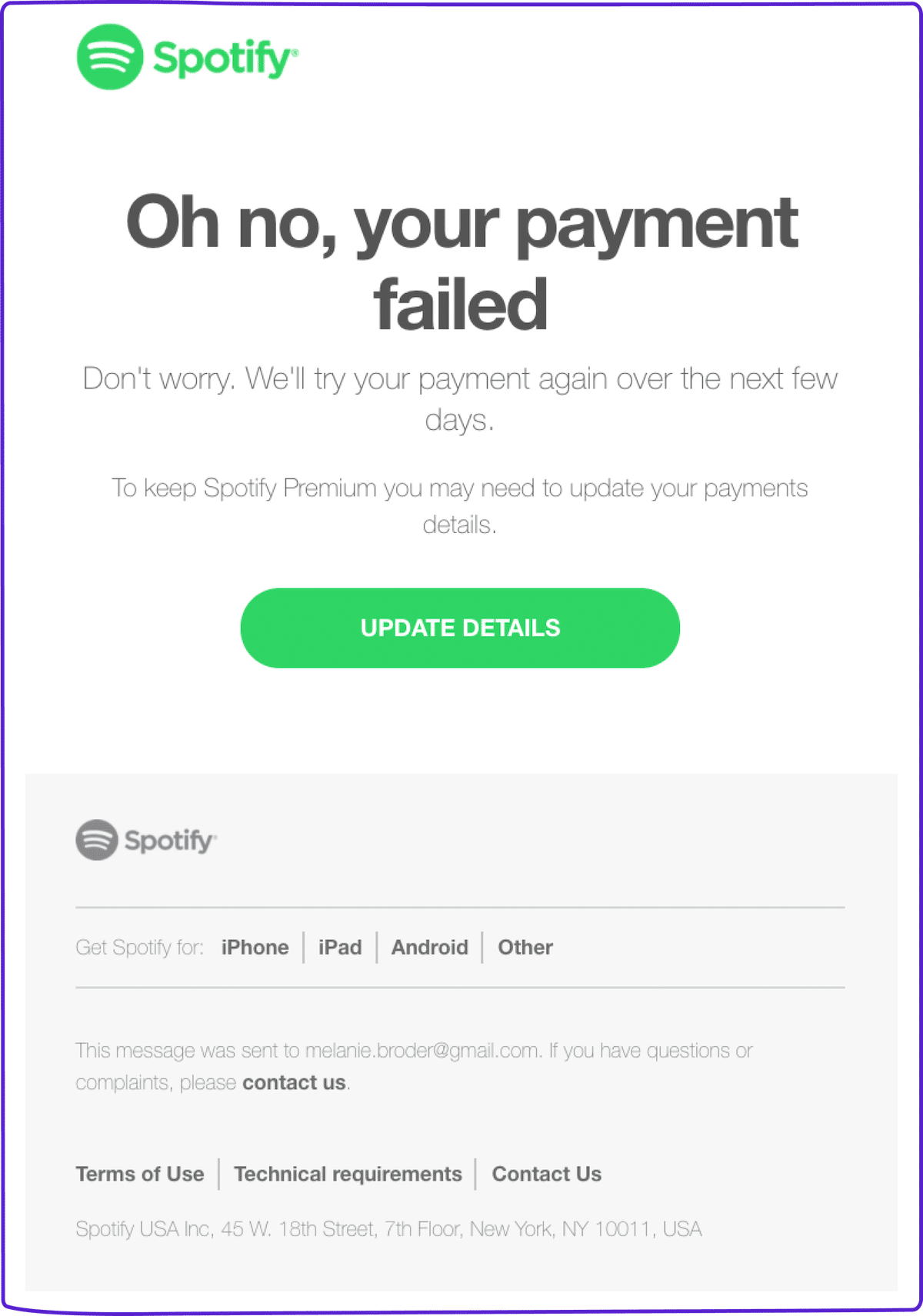
Dunning email example #2: Stitch Fix
Stitch Fix creates a friendly user experience. Customers can rectify their billing issue by clicking the highly visible call to action or emailing the company directly. Their sincerity shines through with the text: “We’ll get right back to you.”

Dunning email example #3: The New York Times
The New York Times rarely buries the lede, and here, they put the call to action in the headline of their payment request email. It’s easy to skim with the links and bolded phrases matching the banner color. And while the tone is firm, the company tells customers what they will lose if they don’t take action now.
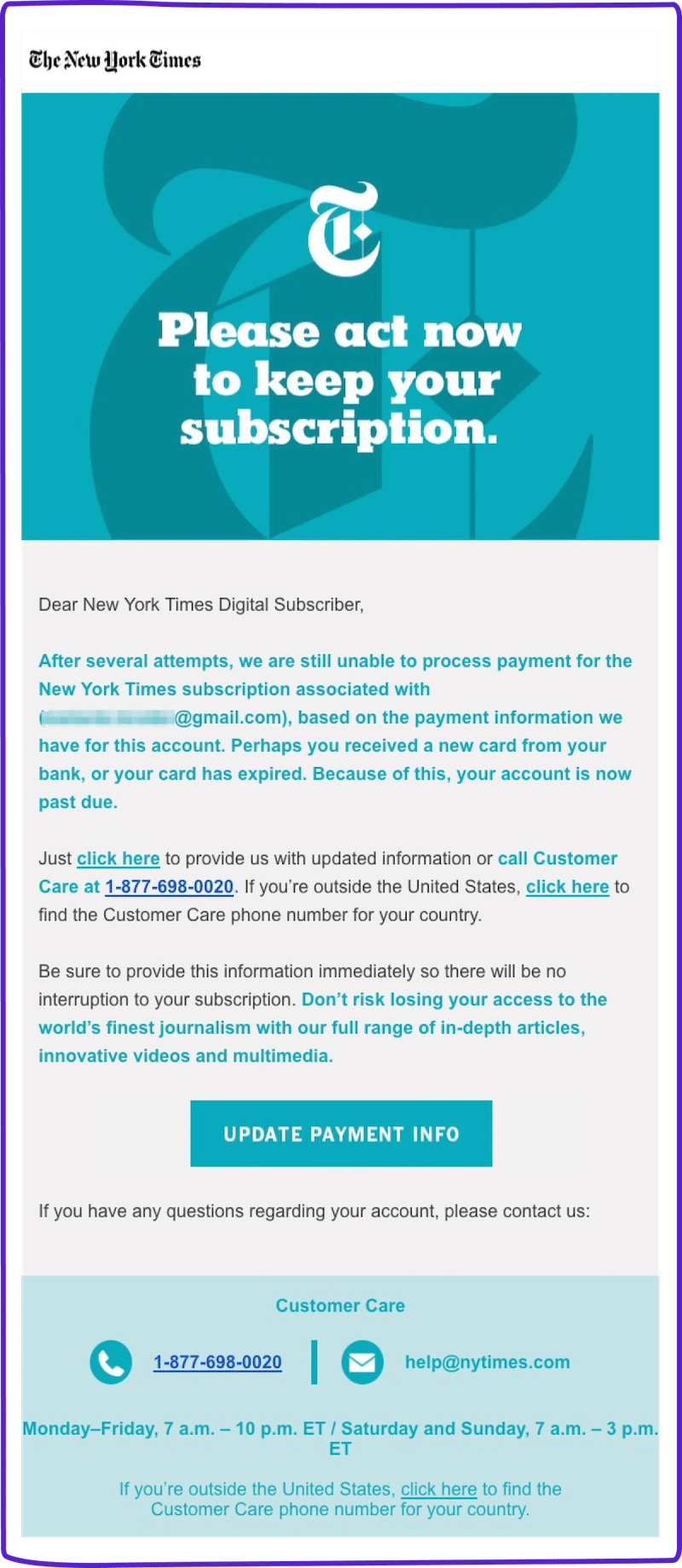
Dunning email example #4: Amazon
Updating payment information should be simple. Amazon takes an instructional approach, laying out the payment process step by step. They don’t leave the subscriber guessing what to do next. Plus, outlining the steps helps the customer deduce the length of the process. Customers can decide to do it now or when they have free time.
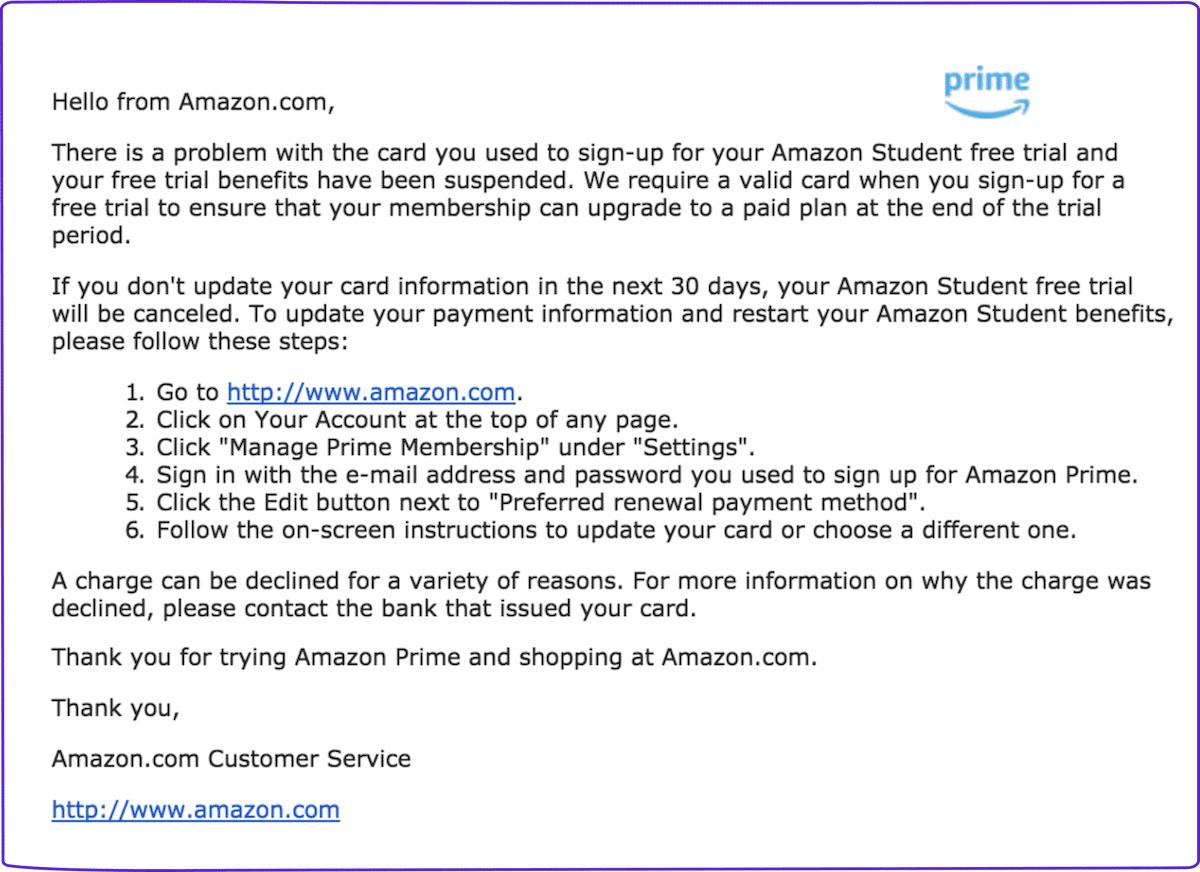
Dunning email example #5: Slack
Slack’s pre-dunning email makes it simple to understand the account renewal process. They include the date that renewal will take place and make it clear this is just a friendly reminder to review billing information.

Dunning email example #6: Chase
Chase creates urgency with design and copy in this example of a dunning email. The red ‘payment due’ text in the hero section of the email immediately grabs attention; you know something is up with your account. They also make it clear that payment in full is not needed. Instead, they give the option to pay the minimum amount if that’s better for you.

Dunning email example #7: Squarespace
When it comes to urgent payment requests, you can turn up the pressure without sending customers into a full-fledged panic. Squarespace has designed their dunning emails with a handy exclamation mark in the top right corner, signaling customers to pay attention to the message. The company mirrors the urgency of the design with their copy.
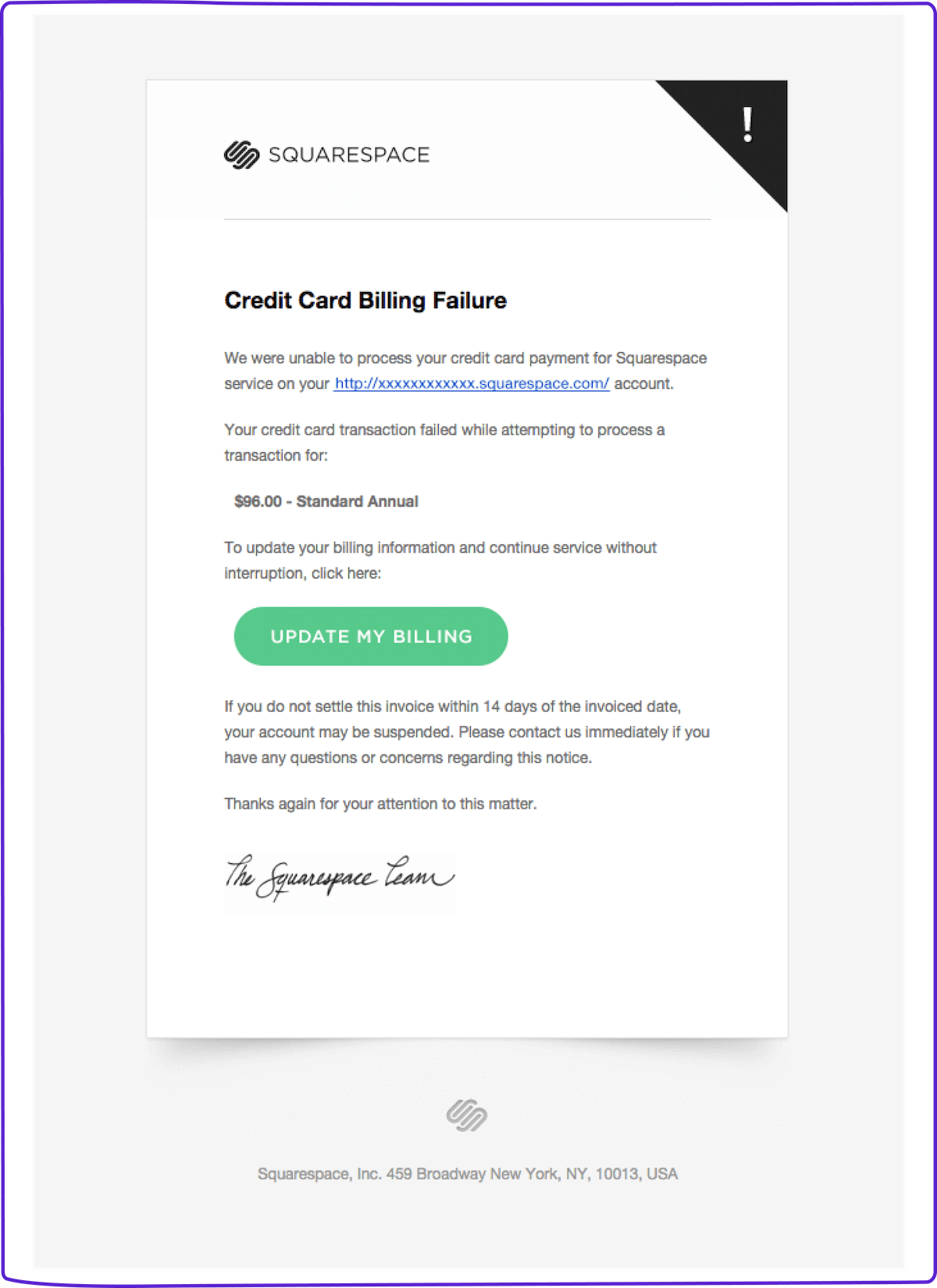
3 dunning email templates (with Customer.io Journeys!)
Feeling inspired? These carefully designed email templates from Customer.io combine persuasive language, strategic elements, and proven techniques to help you craft the perfect dunning email. Even better? Our in-house billing team carefully crafted these emails for our own retention campaigns.
Dunning email 1: Invoice due date approaching (with net terms)
For customer accounts with net terms, we send this email to gently remind them that their annual subscription will be due in a matter of weeks. These payments are typically large, so we want to give our customers enough time to prepare payment for the due date.
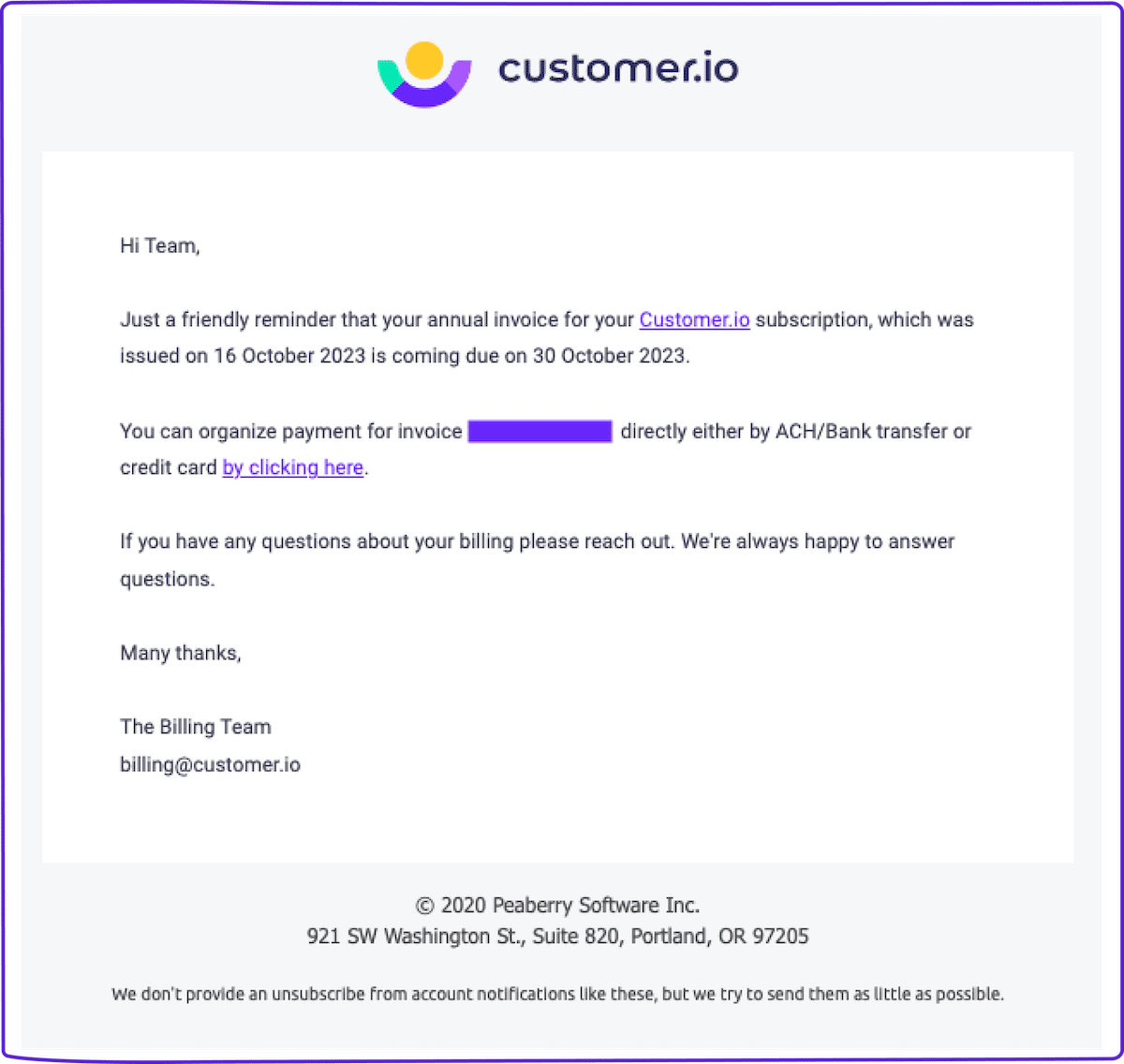
Dunning email 2: Invoice overdue reminder
This email is a friendly reminder that payment is now overdue and allows the customer to rectify the situation. Of course, mistakes happen on both sides. We acknowledge that within the email, in case it just so happens, this is a “it’s not you, it’s me” situation.
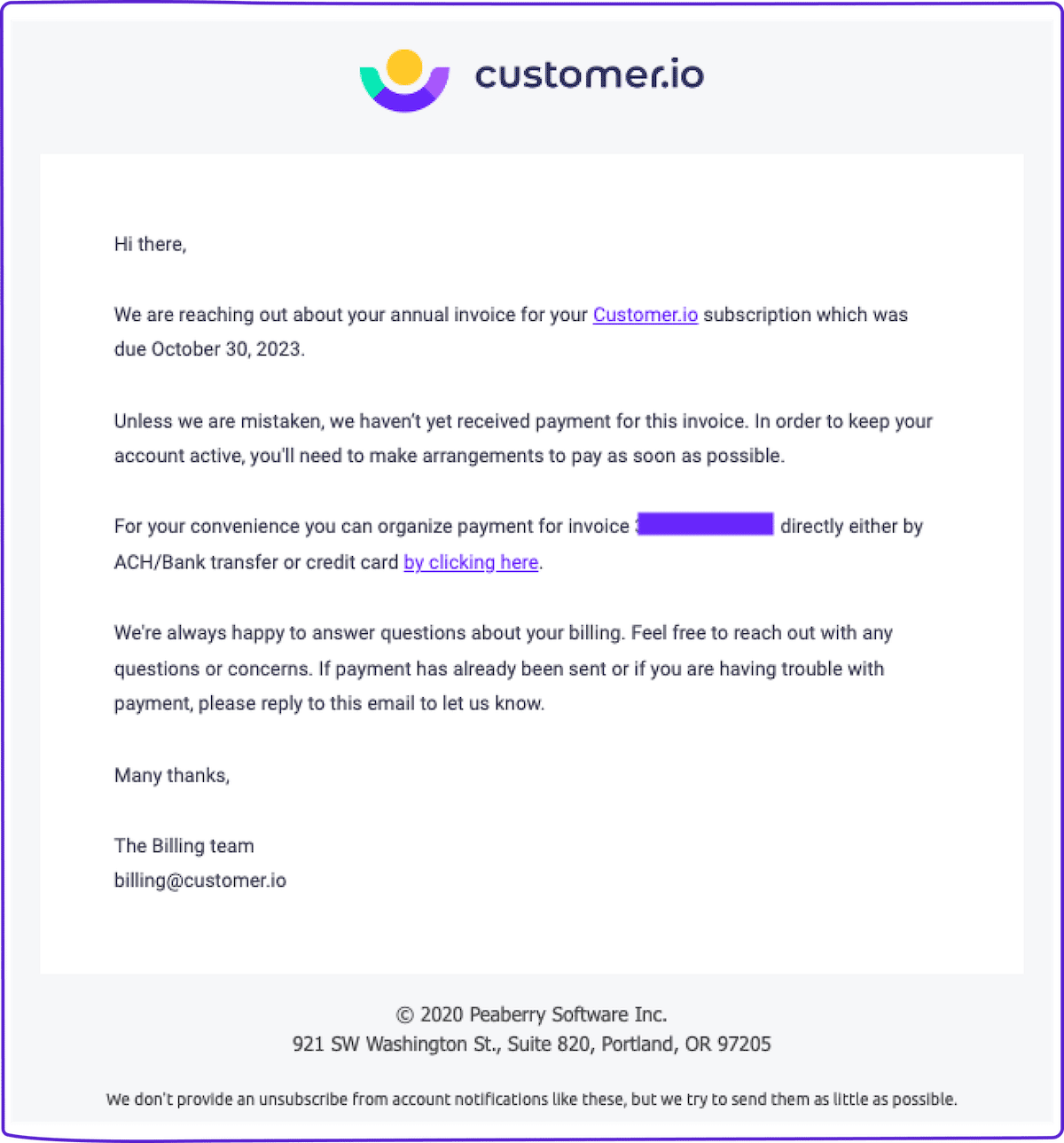
Dunning email 3: Card payment failure
When we cannot charge a card on file, we send this email after a few days to inform the customer that payment was unsuccessful. Pairing it with the message “We’d love to keep giving you service” helps let the customer know that they won’t be able to use our tool if they don’t make payment soon.

Unlocking success: An omnichannel approach to getting paid on time
Dunning emails are undoubtedly a powerful tool for combatting delinquent churn, but you can further amplify their effectiveness by integrating them into a comprehensive retention strategy. That’s where communication channels like SMS, push, and in-app messaging come into play. Of course, volume and cadence are critical—no customer wants to receive all forms of communication at once. But, when executed thoughtfully, your omnichannel workflow can be highly effective.
Here’s a breakdown of how you can use SMS, push, and in-app messaging across different stages of dunning to stop delinquent churn in its tracks!
SMS
Texts are perfect for sending concise yet impactful messages, making them highly effective across all stages of the dunning process.
For example, if you’ve sent an email 30 days before payment is due but have yet to see any action taken on the account within a week, consider sending a text message to customers who’ve provided you with their phone number.
Keep it short and sweet. Reiterate that the deadline is coming up and include a deep link to where they can make payment within your app. When payment is overdue, send an urgent text message with the amount due and payment instructions. You can even include rich media like a picture of the receipt to convey the message better.
Pro tip: If you’ve only given customers the option to opt in or out of SMS, don’t overdo it on this channel. You could risk an unsubscribe completely.
Push
One significant benefit of push notifications is that they appear on the user’s device—even if they’re not actively using your app. Customers can see them from the home screen, lock screen, notification center, or all of the above. That’s great when you need to get an important message in front of your customers.
If you notice that email hasn’t moved the customer to action and payment is still overdue, consider sending a push notification instead.
Consider sending them relatively soon after dunning, such as one day after payment is due and another two days later. Just be sure you’re keeping an eye on how much you’re messaging the customer in other channels. For example, we recommend not sending a push notification the same day as a dunning email.
In-app messaging
Customers cannot opt out of in-app messaging. And, if the customer whose payment is due is actively using your tool, in-app is the perfect way to reach them with a timely payment reminder message.
In-app also naturally reduces friction for the user to complete payment. They’re already in situ, so a quick redirect to the payment page requires fewer clicks on the customer’s part.
Consider using in-app to notify a customer of their current payment status. You might even personalize the in-app message by highlighting a specific feature or service the customer regularly uses (and explaining that they won’t be able to access it should payment not be received).
Dunning emails: drawing attention to retention
Payment notifications are a standard practice. But there’s always room for improvement. Whether it’s your tone or call to action, experiment with new ways to support your customers. The dunning email is your marketing tool to prevent churn and increase retention.
The proactive approach of dunning emails addresses payment issues before they escalate, showcasing a commitment to customer support. Moreover, these emails serve as a tailored marketing tool, emphasizing the ongoing value of services and solidifying why customers should continue their relationship with your brand.
Ready to unlock additional strategies to stop churn and boost loyalty? Grab our Retention Recipes today!